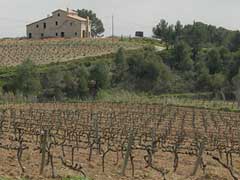Spanish Sparkling Wine Production in Spain
As we mentioned in our overview of cava and its history, true cava can only be called cava if it is made in the traditional method. The method is the same method used to make Champagne - hence why it is called le méthode champenoise - although it has been adapted slightly by the various producers of the drink across the Spanish cava regions.
Today, the annual cava production rate is around 18 million boxes or 12 bottles each, making Spain the second largest producer of sparkling wine in the world, only losing out to the region of Champagne. The most famous production region for cava is the Alto Penedés region near Barcelona, which is where you can find two of the most famous cava brands: Freixenet and Codorníu. These cava producers also offer tours so make sure you pay them a visit if you travel to Barcelona.
The majority of the cava in Spain is produced in Catalonia, but there are also cava cellars in the regions of Aragón, Castilla y León, Extremadura, La Rioja, the Basque Country, Navarre and Valencia. Cava is consumed within Spain but also has a large presence in international markets, becoming the most exported sparkling wine in 2009 - probably something which is best not to mention if you happen to be in a wine bar if you ever visit Paris, or any other part of France. Sales of the Spanish sparkling wine continue to rise, something which has largely been related to the drink's great quality to price ratio.
Grape Varieties
The main types of grapes used in the production of cava are the macabeo, the parellada and the xarel·lo - all of which bring their own unique characteristics to the sparkling wine.

- Macabeo - brings sweetness and perfume to the cava
- Parellada - brings subtlety, freshness and scent to the cava
- Xarel·lo - brings body and structure to the cava
Other varieties such as chardonnay and pinot noir are often used to produce copies of Champagne. There are also secondary varieties which are used such as subirat parent which is also called malvasía. In order to make rosé cavas, they use red varieties such as garnacha, monastrell and trepat.
Production
These grape varieties are therefore used to create the basic still wine, which is then used to make the sparkling wine after the second fermentation. The winemaking process to make this base wine is the same as normal, with a soft pressing of grape musts, then a purifying stage to get rid of the must sediment. Finally the wine is fermented in large tanks. Once the base wine is produced, the wine makings then make the necessary mixtures for the next process.
Second Fermentation
Following the cava making tradition, the next stage is the tirage, which is when the base wine is bottled. To this wine, licor de tirage is then added - a mixture of white wine, sugar and yeast - which produces carbon dioxide and a characteristic smell once allowed to ferment.

The bottles are then left to settle in a horizontal position in a dark location with a constant temperature of 15°C. Bottles are left to age for at least 9 months. After this time, a large amount of sediment can be seen in the bottle which needs to be removed. In the early stages of cava production, this process was done by hand. An overseer would have to swirl the wine around so that the sediment moved towards the bottle's cork. Nowadays, this process is done by the gyropalette - a machine in which several bottles of wine are placed, cork down, and then moved in a similar motion. Thanks to this machine, cava production has become significantly faster and cheaper.
In the traditional fashion, the bottle is then held completely upside down and then uncorked, allowing some of the foam and the sediment to escape. Today, this process occurs during the freezing of the neck of the bottle. When the cork is removed, a block of ice from the neck is removed which contains the sediment within it.
Any lost liquid can be replaced by topping the bottle up with 'licor de expedición'. The amount of sugar added at this point is what determines what type of cava the bottle is. Finally, the corking process in carried out which involves the application of a cork made from natural cork wood, as well as the cover which can be a wire cage or a metal clip.
Spanish Wine History
Spanish Wine Regions and DO
Spanish Wine Tours
Top Spanish designations of origin
Best Spanish Wines
Spanish Wine Production
Spanish Wine Types
Spanish Grapes
Spanish Sparkling Wine: Cava
Sherry Wine
Spanish Wine Cocktails
Spanish Wines in the World
Spanish Wine Prizes
Enotourism
Spanish spirits and liquors
Argentina Wines
Chilean Wines
Other sites